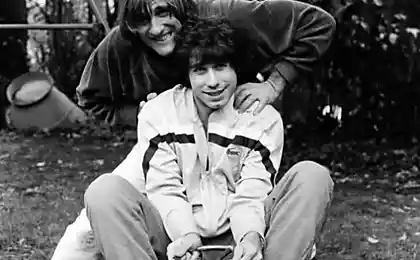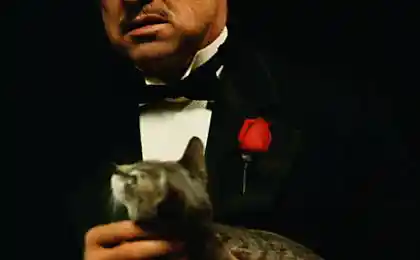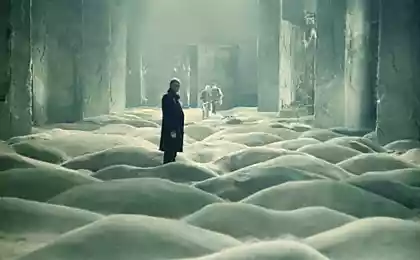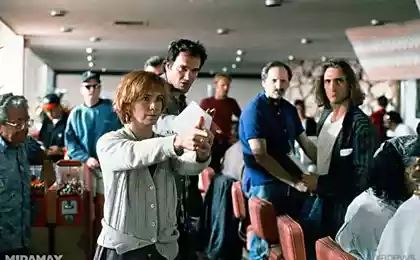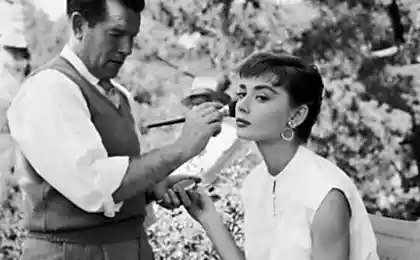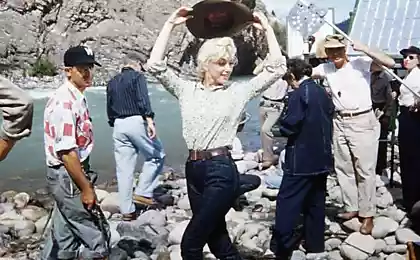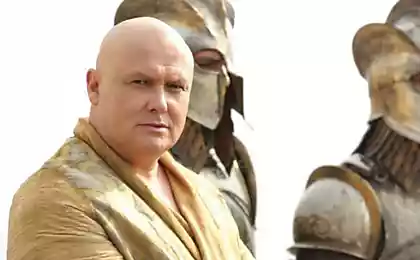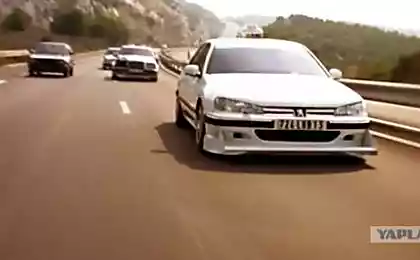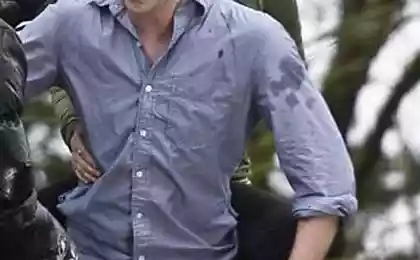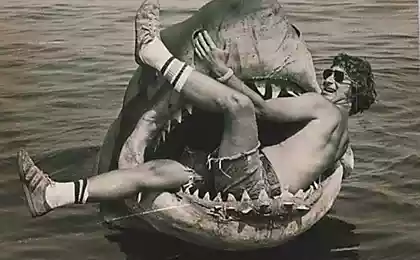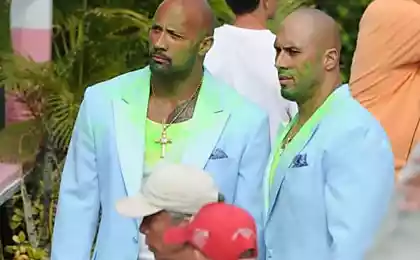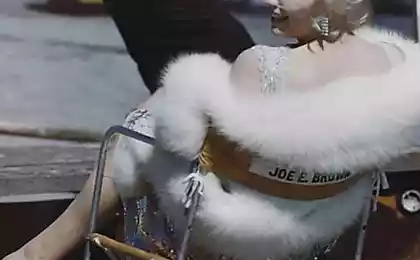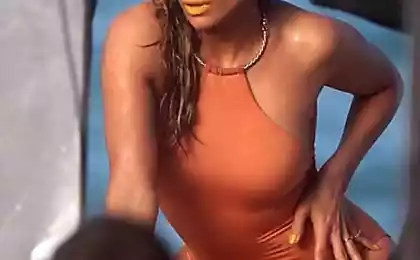1324
My work on the set of "Stalker"
Recently read a post on the establishment of the film "Stalker" and the continuation of this post, I would like to share with you the story of a man who was involved in the shooting process.
1977
After completing military service, I decided not to return to Tsentrnauchfilm, where he worked before, but to get a Mosfilm, because I wanted to work in cinema, because I have not given up hope to enter the kinooperatorsky VGIK. In January 1977 I started to work in this studio as a mechanical maintenance crew film equipment and auxiliary equipment. In contrast to the profession mechanics repair it was the work on set: Setting the camera and charging her film, to ensure its correct operation, the movement of the camera on the dolly or crane. Soon, in terms of the current filming, I saw the title of the film "Stalker" directed by Andrei Tarkovsky.
44 photos via livejournal.
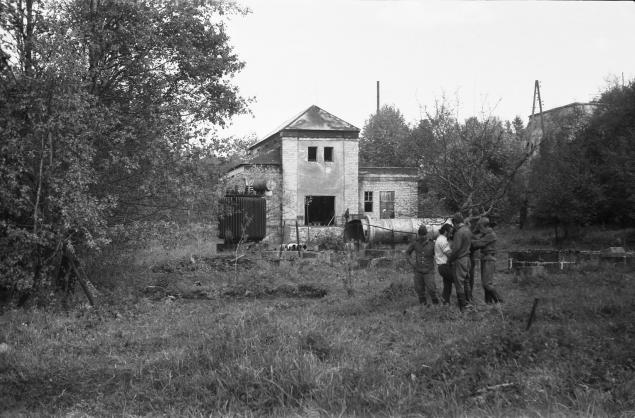
I already knew it was significant and extraordinary director, but as the novel Strugatsky I did not read the name of the movie to me about what does not speak, looking your mysterious and intriguing. Of course, I was curious to know what kind of a movie. I looked into the hall, where the scenery flats Stalker, which in February this year were shot the first scenes of the film, but I did not shoot themselves seen. When I learned that soon will have to continue filming expedition to Estonia, I asked my boss if you can assign to me, to which she replied yes. Since my work was highly technical, including my immediate colleagues I did not have people keen movie-like form of creativity. Besides colleagues knew that the filming of director requirements for all members of the crew are usually elevated, and the work will require much effort. So I easily and without competition entered the film crew. Usually, on the set of full-length feature film in the camera crew consisted of two mechanics: the first was in charge, and the second assistant. In this case, I was the second.
In Estonia, the shooting took place at an abandoned power station on the River Jägala (Jägala), an abandoned dam kilometer from her and at some sites in Tallinn. The power plant and the dam had expressive texture: cracked, covered with lichen concrete, broken glass, oil stains. It seemed that the artists in the preparation of each frame had to simply follow this aesthetic.

Concrete wall of the dam

Filming began in May. The first scene was the approach to the building of heroes power, which was the structure in which there was a cherished room. My colleague began to build an entire railroad turns to a dolly and carefully dub it. The entire group was warned that no one walked on the grass, which was supposed to be in the picture: everything had to look untouched. Then the first time I saw Tarkovsky. He was then 45 years old, but in his appearance I saw some youthful features. He behaved quite simple, it often can be seen in jeans suit.
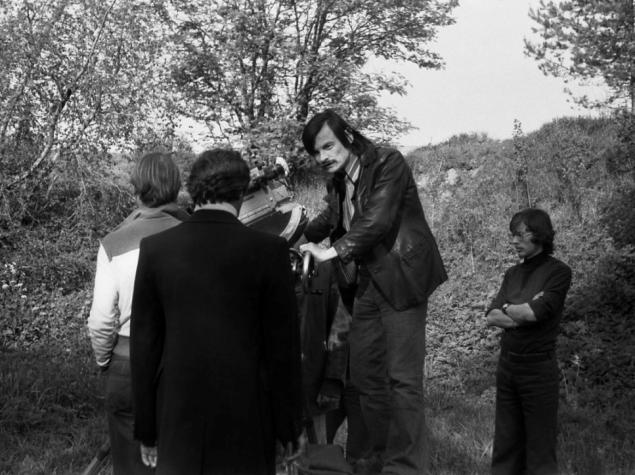
Many scenes of the film were shot in evening mode. This is the shortest part of the day, when the sun had set behind the horizon, but still light. Director of Photography George Rerberg not only illuminates the scene, but, rather, limited light coming from the sky, pulling the camera or the actors on the big black cloth shaders, thus achieving the desired light pattern. This sometimes worked as a single small light fixture, slightly below the highlight the actors' faces in close-ups. Thus, the quantity of light was at the limit of possibility.
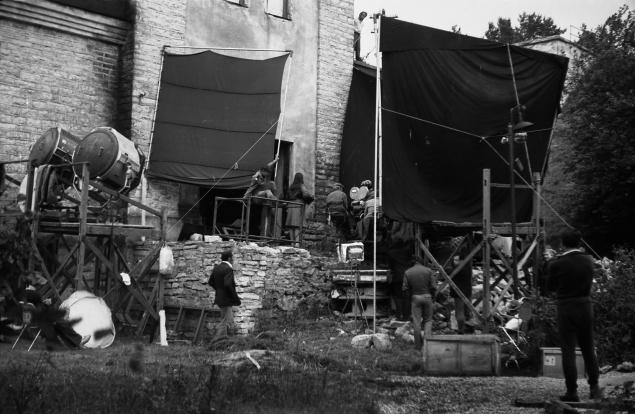
A few days waiting for the Moscow brought Distagony aperture lenses required for such conditions. Filming had, of course, with the full opening of the diaphragm (if not mistaken 1, 2), which created great difficulties for the assistant of focus: on close-up depth of field is virtually no. Generally Rerberg prefer to use lenses with a fixed focal length, as well as the helmsman tripod head. The camera was an old American Mitchell NC (apparently trophy). Rerberg was undoubtedly one of the best masters of their craft in the country at that time.

The birth of this film was difficult. I was not aware of the intricacies of the creative process, as the technology involved, but I knew that already at that time used is not the first version of the script. The characters are not the same as in the final version. If the film is an episode in which the writer's face hits Stalker, then shot a scene in which the assertive and aggressive stalker strikes writers. Apparently it was already invented in Tallinn, because the make-up artist was not even simulate blood and had to use the old cinematic way: someone sent to find cranberry jam. The script even contained a number of effects sci-fi character, showing oddly areas from which Tarkovsky later almost completely abandoned. You're throwing the nuts with a bandage attached to them, but does not explain the meaning of this action. One of these nuts for many years on the wall of my room. I filmed an episode in which hanging on the pole lamp suddenly lighted up brightly and then burn out. In the finished film, the lamp is appear in another episode.
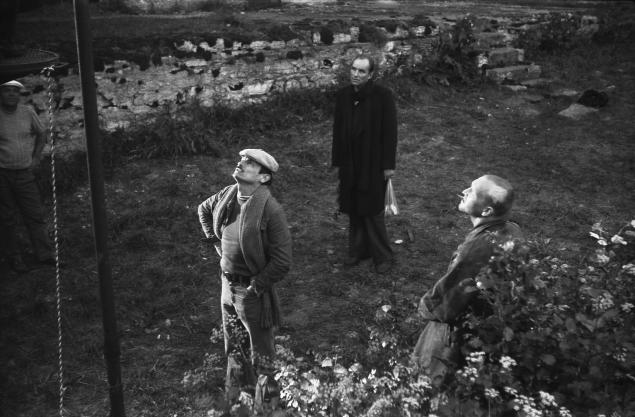
8.
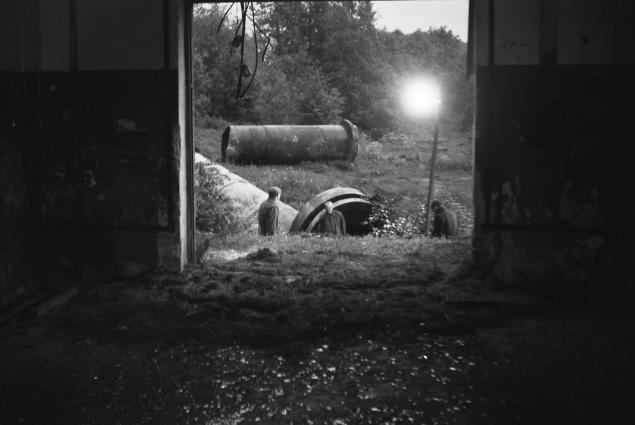
In another episode writer found himself in a place where all of a sudden started to get wet, it just dripped with moisture. Then she quickly evaporated whole. To take this effect was made of rubber branched system of tubes that Solonitsin had to wear a coat, and at the right time one should pour the water. Rapidly melting wet footprint on a sheet of iron was removed from acetone and a blowtorch.
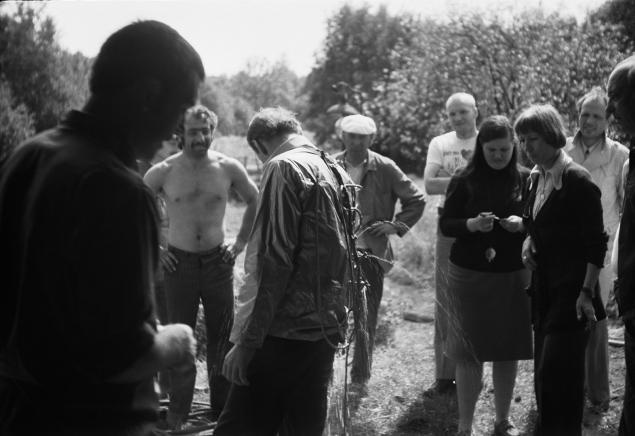
10.
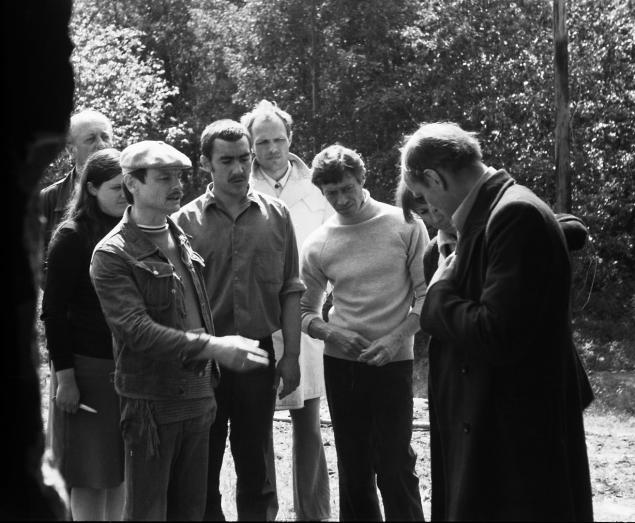
There was also a dialogue of three characters in the interior of the power so that the moving camera discreetly passed on to the viewer in a mirror, and the audience suddenly saw the same scene in a mirror-inverted form. A little different game with the space has been expressed in the frame, which is built on a dam. Mezhuyev rails on which the trolley was a mirror with a camera lying on it from moss and sand was laid still life, a landscape reminiscent of a bird's flight, with the mirror was like on the surface of the reservoir, which reflects the sky. The camera, looking at the view from above, swam over him, the transition to the water and climbing, appeared on the real landscape with a river. This is one of the first two frames of the shooting period, which included in the final version of the film. However, his start was cut off, and the effect of the scale of the game space is missing. This motif is then heard in the next two films of Tarkovsky.

12.
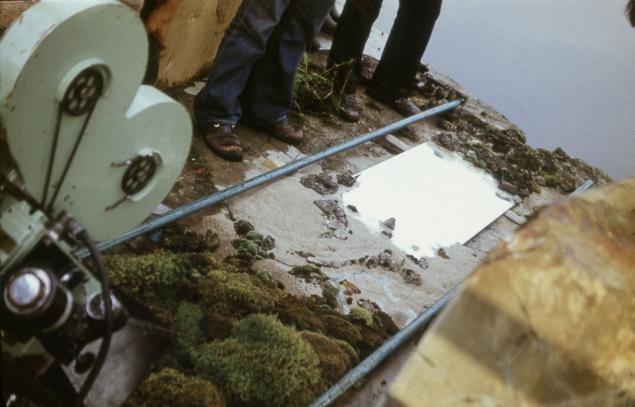
The second frame remains in the film, was kind of the river, completely covered reddish foam flakes which the wind whirls in the air. It was not a special effect: in this river merged Waste Pulp and Paper Mill, and it was very dirty. However, small fish, oddly enough, it vodilas. A few years later, when it turned out that many members of the crew are dead, there were rumors that the cause is the poisoned area in which the shooting took place, allegedly even radiation. But no concrete facts about this I do not know.
In addition to being constantly reworked the script, some of the scenes of the film retake again. This produces a strange impression: if it were not Tarkovsky Rerberg and nobody famous people, I would have suspected of incompetence.

14.
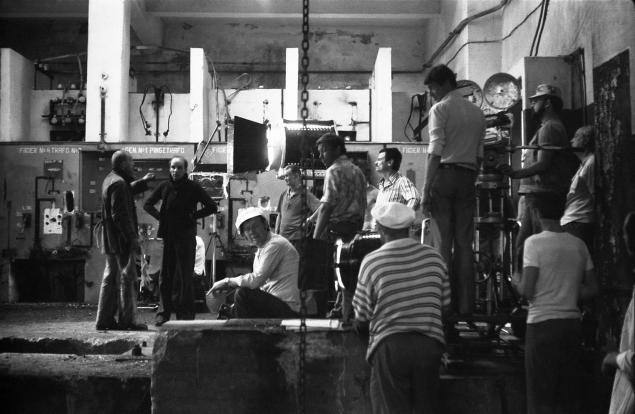
The removed material is transported to Moscow for the developing unit, and then brought to a positive working. I was on the first viewing at the studio "Tallinn-film." The image looks dark and greenish.
It is two blocks from the same afterwards the rejected material:
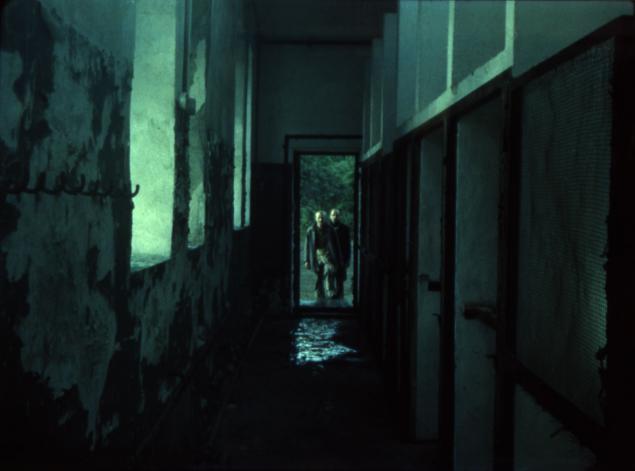
16.

In the future, viewing the material occurs in a narrower range. Then I thought, "Well, this draft positive, then printed, as it should." But it was more difficult. On the creative challenges I learned later, and now film crew had to leave the second operator, is responsible for the exhibition, although I very much doubt that he was guilty; then art director Alexander Boim - an accomplished artist and a movie theater. We began to replace one or the other member of the crew. One day turn and me, I was told, without explanation, that I'm going to Moscow. And I left. I had the impression that the initiator of all this was not leapfrog Tarkovsky, and some of his associates. At the studio heads do not ask me any questions, apparently realizing that this is some kind of game. Finally, I had to leave and Rerberg. Instead, he was invited Leonid Kalashnikov, who came with his assistants. Something even had time to remove, and then work stopped - it was the fall.
I continued to work at the studio, took part in the filming of the movie "Emelyan Pugachev" held in Belarus. Meanwhile, the fate of "Stalker". It was agreed that the failure of the party to blame for poor quality film (Kodak 5247) and improper film development
This seems odd, because it was to be seen even before the shooting at all stages of trial. It was possible to draw the film as a two-part, and in this regard has been allocated funds to continue filming. Again, the script has been altered, and in fact, it was decided to re-shoot all over again.
It's a box from under the very same ill-fated film.
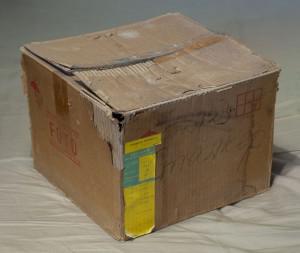
1978
Spring had resumed work on the same objects, and the assistant operator invited me to join the group operator.
Director of photography was Alexander Knyazhinskiy. It was a good master, but my impression was not feeling well independently as Rerberg, and from that experience internal tension. Now survey was conducted at the camera IOS, which is a Soviet copy of the American chamber Mitchell NC, and virtually the entire film except for close-ups of travel in the area was lifted zoom Cooke Varotal (if not mistaken 25-250, T 3, 2). This high quality English lens with variable focal length for film cameras filming the size of an artillery shell and the cost of a car. I still was second mechanic, but first, more experienced, who has worked at the studio for 20 years, seeing that I am fully functional, giving me the opportunity to work at the site on their own, for which I am grateful. In the films of Tarkovsky's camera often moves long and slow. On the set of "Stalker" in most cases, this movement had to carry me.
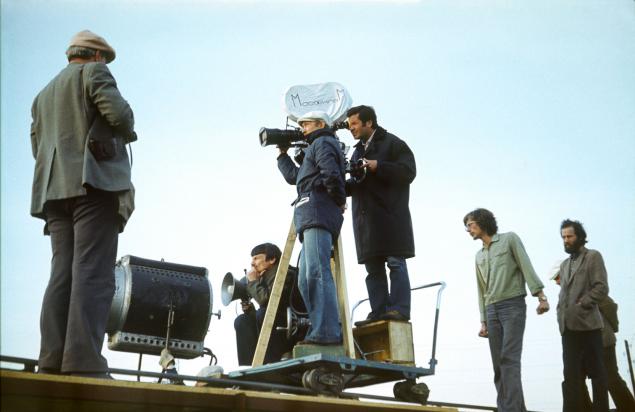
And here we are again in Estonia. We started coming to the stage zone when movie characters trolley stop and continue on foot.
Stills from
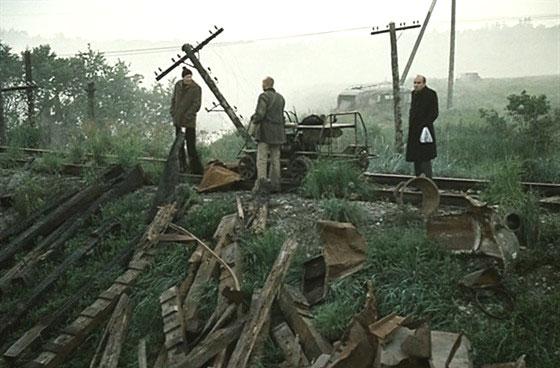
20.

We see in the distance the abandoned military equipment. Part of it was real, specially brought from Moscow, and the rest did decorators. Preparing for the shooting he was worn away with pyrotechnics smoke bombs, following the direction of the wind and creating the effect of fog.
Near the power station filmed a memorable scene in the film when the camera closeup lying Stalker goes to the water lying in her objects and floats above it. In the finished film at this time we hear a child's voice, to read fragments of the Apocalypse (6.12-16).
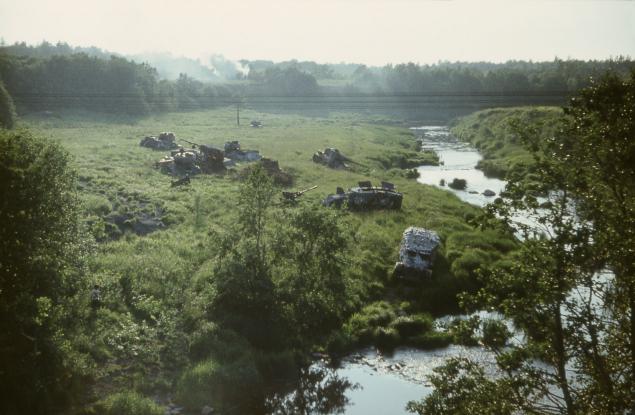
This was at the bottom of a small canal, previously poured water on the turbine plant. At this time the water was about ankle deep. Kajdanovsky lying almost in the water, but underneath it is something planted. The weather was quite cool, costume designer Nelly Fomina came up to the actor to wear a suit playing other special waterproof and warmed for divers, so as not to chill.

The rails were laid on each side of the actor, and the truck with the camera is in an unusual way: the right wheel on the right rails, and the left on the left, so the actor is under the truck.
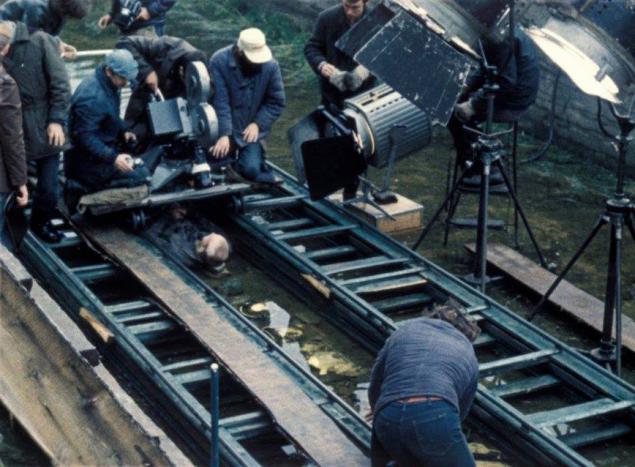
The camera was on a tripod at the lowest edge of the truck and looked down on the actor. When, during the filming, she drove over him, he got up, the transition to a new location where the camera saw him in the final frame. I remember, Andrei Tarkovsky asked me: "Serge, you can drive the distance in 3 minutes?". I said, "Let's try." It is to include a stopwatch, gave the command "Go", and I slowly began to roll a cart, considering himself a second.
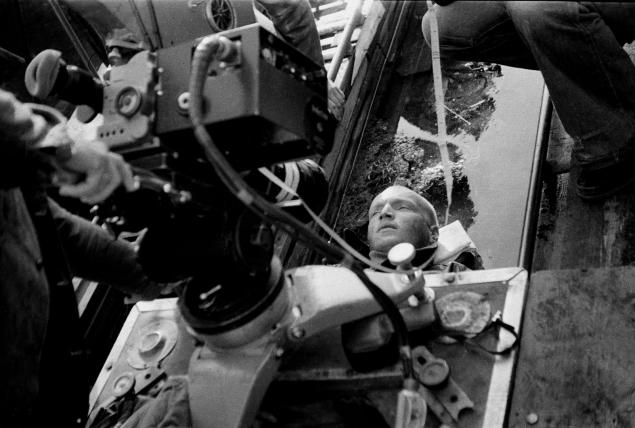
Generally people in my profession have been assistant chief operator, and with the director could not even talk. But since Andrei Tarkovsky participate fully in the filming process, in rehearsal, he often took the place of the operator behind the camera, and I can safely say that I worked with him.
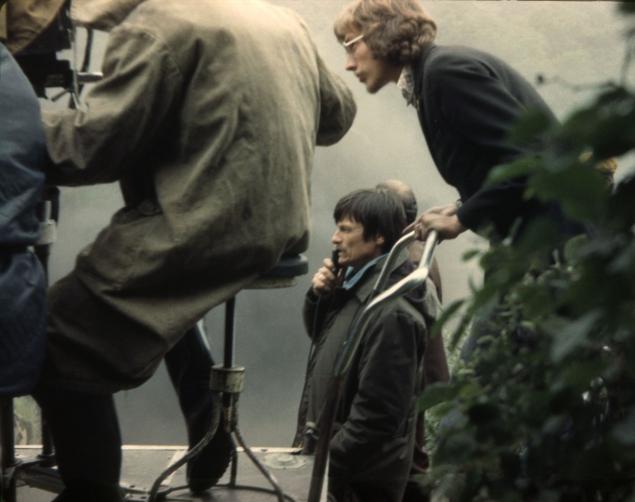
Also, he participated actively in the work of decorators, paying attention to every detail in the picture. "Make us ikebana!" - Joking he told them.
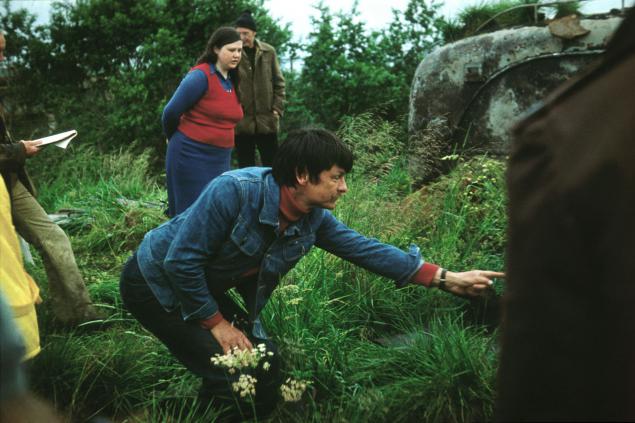
27.
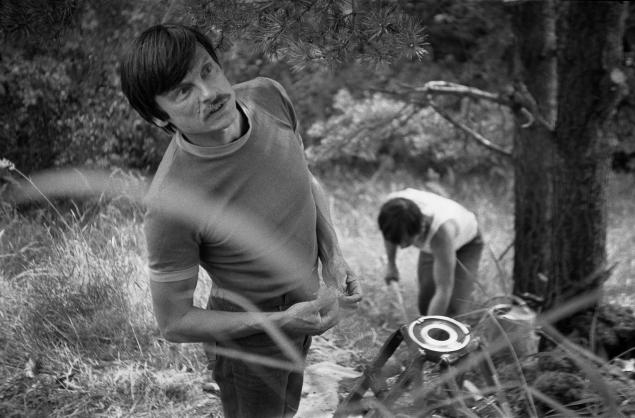
Sometimes the shooting took place in cool weather. "Without Kaifu no Life" - once spoke Solonitsin, lying at a rehearsal on wet moss, surrounded by water, as required by the episode. For the entire group, he was Tolia and Kajdanovsky Sasha Grinko also was called Nikolai Grigoryevich, apparently by seniority.
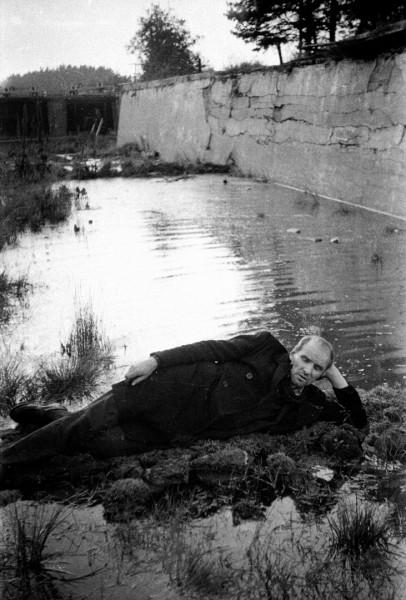
Water - a favorite theme of Tarkovsky, and then it was a lot. Sometimes we had even on a wooden tripod wear rubber boots.
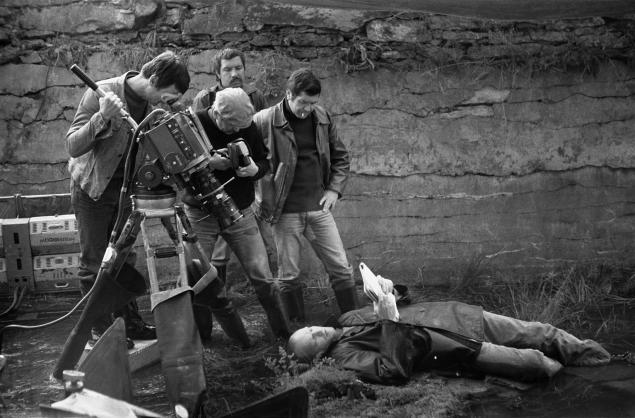
30.

Kinosёmochny process largely consists of expectations and, despite the tense situation, it was time for a rest, for example, play dice or talk about something extraneous. I remember that one day Tarkovsky said he loved the genre of westerns, and willingly would remove something like that. I think that if he was shooting a Western, it would be similar to the prologue of the film "Once Upon A Time In The West" (1968). Actually, he was super-critical, once I said about Spielberg that his films is generally not a movie (probably it could be because of the "Jaws"). I did not join this conversation, but I remember that back then disagreed. In my opinion a good movie is very different - Spielberg is good in its own way, in their own way Bergman.

From the beginning to the end of the filming of this movie, and in 1977, and in 1978, he worked on the set of Mosfilm staff photographer Vladimir Markovich Murashko (now deceased) and, as was customary, each recorded any meaningful frame of the movie, as well, as well as working moments filming. He had a high-quality camera Hasselblad c frame size 6x6 cm. But shots from the shooting of the film that I have seen in books, periodicals and the Internet, only a few I could presumably be attributed to his authorship. Where is the rest of the material, it would be interesting to know.
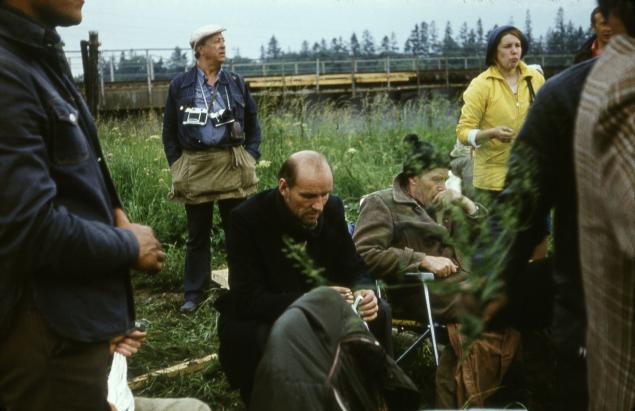
I myself took quite a bit of intelligent staff because did not yet sufficient to determine for themselves their tasks, as a person with a camera, what is generally removed. In addition, the most interesting moments, I was usually busy with their main job, and also because of the tense situation during the filming I was uncomfortable to be active in this matter.
Photo Nelly Fomina

I was then the camera Zenit 3M and old German Voightländer with an accordion for glass plates 6x9 cm, which I also tried to shoot. Once Tarkovsky noticed it and told me that his father was like. Talking with him, I said, "Well, let's you and I wanted this machine." I suggested that he take a step back to get away from the direct sun and take a single shot. It turned out blurry, and for many years I thought he was unsuccessful. Then, scanning the negative and adjusting in Photoshop, I thought, "No sharpness happiness - but it is looking at the viewer smiling, another of the frame I have not seen.»

Some working moments filming in Estonia and filmed a movie camera. It instructed M. Vasiliev from Alma-Ata, who was in the control group of trainee. I've never seen this footage. I wonder where he is.
This is a frame of this film material on it Knyazhinskiy director of photography I do.
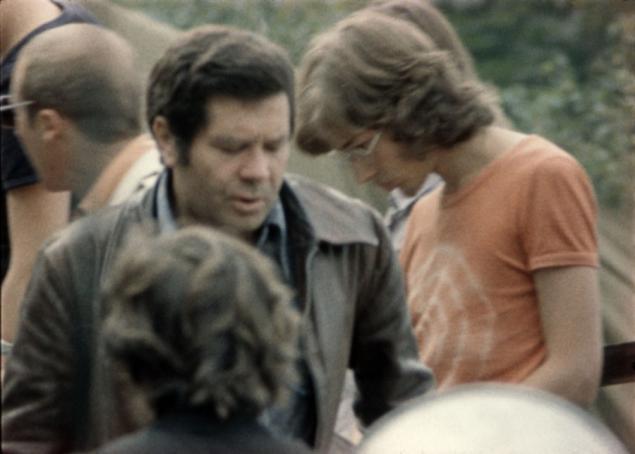
The scene in which the characters sit on the rail car and drive off, filmed in Tallinn in an abandoned storage unit. In episodes of travel in the zone appear police. They conditional uniforms, as was to be unclear in which country the action is. If you look on their helmets can be seen connected by the letters "AT", which are actually the initials of the director. These same letters can be seen on a pack of cigarettes that smokers wife Stalker.
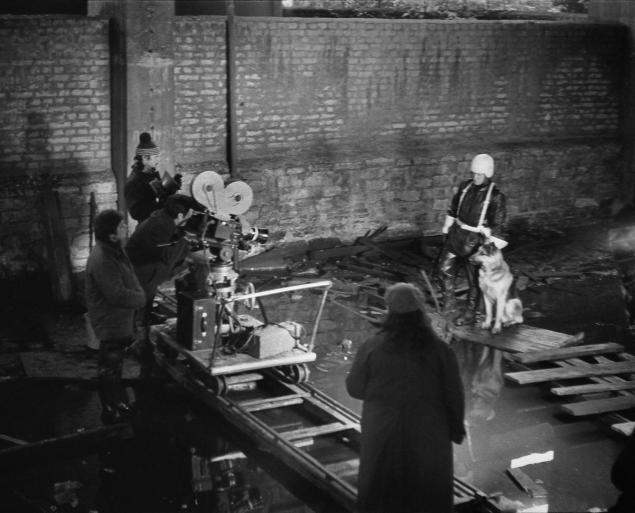
On the outskirts of the city other industrial capture close-up directions in the zone. The actors were not on the trolley and on the railway platform, which rolled on rails locomotive. Next to them were laid rails for the trolley operator, where the operator sat, holding a camera Arriflex, equipped with a stabilizing system Steadycam, quenching her shaking and jerking, and thus provide it more smooth movement. I moved the cart, which allows the camera to switch from one actor to another.
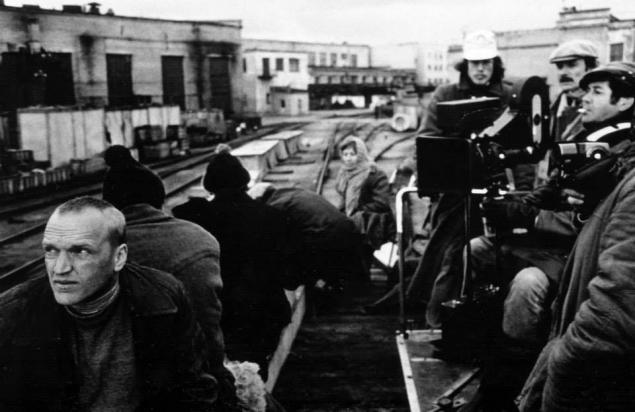
38.

P.S.
1977
After completing military service, I decided not to return to Tsentrnauchfilm, where he worked before, but to get a Mosfilm, because I wanted to work in cinema, because I have not given up hope to enter the kinooperatorsky VGIK. In January 1977 I started to work in this studio as a mechanical maintenance crew film equipment and auxiliary equipment. In contrast to the profession mechanics repair it was the work on set: Setting the camera and charging her film, to ensure its correct operation, the movement of the camera on the dolly or crane. Soon, in terms of the current filming, I saw the title of the film "Stalker" directed by Andrei Tarkovsky.
44 photos via livejournal.

I already knew it was significant and extraordinary director, but as the novel Strugatsky I did not read the name of the movie to me about what does not speak, looking your mysterious and intriguing. Of course, I was curious to know what kind of a movie. I looked into the hall, where the scenery flats Stalker, which in February this year were shot the first scenes of the film, but I did not shoot themselves seen. When I learned that soon will have to continue filming expedition to Estonia, I asked my boss if you can assign to me, to which she replied yes. Since my work was highly technical, including my immediate colleagues I did not have people keen movie-like form of creativity. Besides colleagues knew that the filming of director requirements for all members of the crew are usually elevated, and the work will require much effort. So I easily and without competition entered the film crew. Usually, on the set of full-length feature film in the camera crew consisted of two mechanics: the first was in charge, and the second assistant. In this case, I was the second.
In Estonia, the shooting took place at an abandoned power station on the River Jägala (Jägala), an abandoned dam kilometer from her and at some sites in Tallinn. The power plant and the dam had expressive texture: cracked, covered with lichen concrete, broken glass, oil stains. It seemed that the artists in the preparation of each frame had to simply follow this aesthetic.

Concrete wall of the dam

Filming began in May. The first scene was the approach to the building of heroes power, which was the structure in which there was a cherished room. My colleague began to build an entire railroad turns to a dolly and carefully dub it. The entire group was warned that no one walked on the grass, which was supposed to be in the picture: everything had to look untouched. Then the first time I saw Tarkovsky. He was then 45 years old, but in his appearance I saw some youthful features. He behaved quite simple, it often can be seen in jeans suit.

Many scenes of the film were shot in evening mode. This is the shortest part of the day, when the sun had set behind the horizon, but still light. Director of Photography George Rerberg not only illuminates the scene, but, rather, limited light coming from the sky, pulling the camera or the actors on the big black cloth shaders, thus achieving the desired light pattern. This sometimes worked as a single small light fixture, slightly below the highlight the actors' faces in close-ups. Thus, the quantity of light was at the limit of possibility.

A few days waiting for the Moscow brought Distagony aperture lenses required for such conditions. Filming had, of course, with the full opening of the diaphragm (if not mistaken 1, 2), which created great difficulties for the assistant of focus: on close-up depth of field is virtually no. Generally Rerberg prefer to use lenses with a fixed focal length, as well as the helmsman tripod head. The camera was an old American Mitchell NC (apparently trophy). Rerberg was undoubtedly one of the best masters of their craft in the country at that time.

The birth of this film was difficult. I was not aware of the intricacies of the creative process, as the technology involved, but I knew that already at that time used is not the first version of the script. The characters are not the same as in the final version. If the film is an episode in which the writer's face hits Stalker, then shot a scene in which the assertive and aggressive stalker strikes writers. Apparently it was already invented in Tallinn, because the make-up artist was not even simulate blood and had to use the old cinematic way: someone sent to find cranberry jam. The script even contained a number of effects sci-fi character, showing oddly areas from which Tarkovsky later almost completely abandoned. You're throwing the nuts with a bandage attached to them, but does not explain the meaning of this action. One of these nuts for many years on the wall of my room. I filmed an episode in which hanging on the pole lamp suddenly lighted up brightly and then burn out. In the finished film, the lamp is appear in another episode.

8.

In another episode writer found himself in a place where all of a sudden started to get wet, it just dripped with moisture. Then she quickly evaporated whole. To take this effect was made of rubber branched system of tubes that Solonitsin had to wear a coat, and at the right time one should pour the water. Rapidly melting wet footprint on a sheet of iron was removed from acetone and a blowtorch.

10.

There was also a dialogue of three characters in the interior of the power so that the moving camera discreetly passed on to the viewer in a mirror, and the audience suddenly saw the same scene in a mirror-inverted form. A little different game with the space has been expressed in the frame, which is built on a dam. Mezhuyev rails on which the trolley was a mirror with a camera lying on it from moss and sand was laid still life, a landscape reminiscent of a bird's flight, with the mirror was like on the surface of the reservoir, which reflects the sky. The camera, looking at the view from above, swam over him, the transition to the water and climbing, appeared on the real landscape with a river. This is one of the first two frames of the shooting period, which included in the final version of the film. However, his start was cut off, and the effect of the scale of the game space is missing. This motif is then heard in the next two films of Tarkovsky.

12.

The second frame remains in the film, was kind of the river, completely covered reddish foam flakes which the wind whirls in the air. It was not a special effect: in this river merged Waste Pulp and Paper Mill, and it was very dirty. However, small fish, oddly enough, it vodilas. A few years later, when it turned out that many members of the crew are dead, there were rumors that the cause is the poisoned area in which the shooting took place, allegedly even radiation. But no concrete facts about this I do not know.
In addition to being constantly reworked the script, some of the scenes of the film retake again. This produces a strange impression: if it were not Tarkovsky Rerberg and nobody famous people, I would have suspected of incompetence.

14.

The removed material is transported to Moscow for the developing unit, and then brought to a positive working. I was on the first viewing at the studio "Tallinn-film." The image looks dark and greenish.
It is two blocks from the same afterwards the rejected material:

16.

In the future, viewing the material occurs in a narrower range. Then I thought, "Well, this draft positive, then printed, as it should." But it was more difficult. On the creative challenges I learned later, and now film crew had to leave the second operator, is responsible for the exhibition, although I very much doubt that he was guilty; then art director Alexander Boim - an accomplished artist and a movie theater. We began to replace one or the other member of the crew. One day turn and me, I was told, without explanation, that I'm going to Moscow. And I left. I had the impression that the initiator of all this was not leapfrog Tarkovsky, and some of his associates. At the studio heads do not ask me any questions, apparently realizing that this is some kind of game. Finally, I had to leave and Rerberg. Instead, he was invited Leonid Kalashnikov, who came with his assistants. Something even had time to remove, and then work stopped - it was the fall.
I continued to work at the studio, took part in the filming of the movie "Emelyan Pugachev" held in Belarus. Meanwhile, the fate of "Stalker". It was agreed that the failure of the party to blame for poor quality film (Kodak 5247) and improper film development
This seems odd, because it was to be seen even before the shooting at all stages of trial. It was possible to draw the film as a two-part, and in this regard has been allocated funds to continue filming. Again, the script has been altered, and in fact, it was decided to re-shoot all over again.
It's a box from under the very same ill-fated film.

1978
Spring had resumed work on the same objects, and the assistant operator invited me to join the group operator.
Director of photography was Alexander Knyazhinskiy. It was a good master, but my impression was not feeling well independently as Rerberg, and from that experience internal tension. Now survey was conducted at the camera IOS, which is a Soviet copy of the American chamber Mitchell NC, and virtually the entire film except for close-ups of travel in the area was lifted zoom Cooke Varotal (if not mistaken 25-250, T 3, 2). This high quality English lens with variable focal length for film cameras filming the size of an artillery shell and the cost of a car. I still was second mechanic, but first, more experienced, who has worked at the studio for 20 years, seeing that I am fully functional, giving me the opportunity to work at the site on their own, for which I am grateful. In the films of Tarkovsky's camera often moves long and slow. On the set of "Stalker" in most cases, this movement had to carry me.

And here we are again in Estonia. We started coming to the stage zone when movie characters trolley stop and continue on foot.
Stills from

20.

We see in the distance the abandoned military equipment. Part of it was real, specially brought from Moscow, and the rest did decorators. Preparing for the shooting he was worn away with pyrotechnics smoke bombs, following the direction of the wind and creating the effect of fog.
Near the power station filmed a memorable scene in the film when the camera closeup lying Stalker goes to the water lying in her objects and floats above it. In the finished film at this time we hear a child's voice, to read fragments of the Apocalypse (6.12-16).

This was at the bottom of a small canal, previously poured water on the turbine plant. At this time the water was about ankle deep. Kajdanovsky lying almost in the water, but underneath it is something planted. The weather was quite cool, costume designer Nelly Fomina came up to the actor to wear a suit playing other special waterproof and warmed for divers, so as not to chill.

The rails were laid on each side of the actor, and the truck with the camera is in an unusual way: the right wheel on the right rails, and the left on the left, so the actor is under the truck.

The camera was on a tripod at the lowest edge of the truck and looked down on the actor. When, during the filming, she drove over him, he got up, the transition to a new location where the camera saw him in the final frame. I remember, Andrei Tarkovsky asked me: "Serge, you can drive the distance in 3 minutes?". I said, "Let's try." It is to include a stopwatch, gave the command "Go", and I slowly began to roll a cart, considering himself a second.

Generally people in my profession have been assistant chief operator, and with the director could not even talk. But since Andrei Tarkovsky participate fully in the filming process, in rehearsal, he often took the place of the operator behind the camera, and I can safely say that I worked with him.

Also, he participated actively in the work of decorators, paying attention to every detail in the picture. "Make us ikebana!" - Joking he told them.

27.

Sometimes the shooting took place in cool weather. "Without Kaifu no Life" - once spoke Solonitsin, lying at a rehearsal on wet moss, surrounded by water, as required by the episode. For the entire group, he was Tolia and Kajdanovsky Sasha Grinko also was called Nikolai Grigoryevich, apparently by seniority.

Water - a favorite theme of Tarkovsky, and then it was a lot. Sometimes we had even on a wooden tripod wear rubber boots.

30.

Kinosёmochny process largely consists of expectations and, despite the tense situation, it was time for a rest, for example, play dice or talk about something extraneous. I remember that one day Tarkovsky said he loved the genre of westerns, and willingly would remove something like that. I think that if he was shooting a Western, it would be similar to the prologue of the film "Once Upon A Time In The West" (1968). Actually, he was super-critical, once I said about Spielberg that his films is generally not a movie (probably it could be because of the "Jaws"). I did not join this conversation, but I remember that back then disagreed. In my opinion a good movie is very different - Spielberg is good in its own way, in their own way Bergman.

From the beginning to the end of the filming of this movie, and in 1977, and in 1978, he worked on the set of Mosfilm staff photographer Vladimir Markovich Murashko (now deceased) and, as was customary, each recorded any meaningful frame of the movie, as well, as well as working moments filming. He had a high-quality camera Hasselblad c frame size 6x6 cm. But shots from the shooting of the film that I have seen in books, periodicals and the Internet, only a few I could presumably be attributed to his authorship. Where is the rest of the material, it would be interesting to know.

I myself took quite a bit of intelligent staff because did not yet sufficient to determine for themselves their tasks, as a person with a camera, what is generally removed. In addition, the most interesting moments, I was usually busy with their main job, and also because of the tense situation during the filming I was uncomfortable to be active in this matter.
Photo Nelly Fomina

I was then the camera Zenit 3M and old German Voightländer with an accordion for glass plates 6x9 cm, which I also tried to shoot. Once Tarkovsky noticed it and told me that his father was like. Talking with him, I said, "Well, let's you and I wanted this machine." I suggested that he take a step back to get away from the direct sun and take a single shot. It turned out blurry, and for many years I thought he was unsuccessful. Then, scanning the negative and adjusting in Photoshop, I thought, "No sharpness happiness - but it is looking at the viewer smiling, another of the frame I have not seen.»

Some working moments filming in Estonia and filmed a movie camera. It instructed M. Vasiliev from Alma-Ata, who was in the control group of trainee. I've never seen this footage. I wonder where he is.
This is a frame of this film material on it Knyazhinskiy director of photography I do.

The scene in which the characters sit on the rail car and drive off, filmed in Tallinn in an abandoned storage unit. In episodes of travel in the zone appear police. They conditional uniforms, as was to be unclear in which country the action is. If you look on their helmets can be seen connected by the letters "AT", which are actually the initials of the director. These same letters can be seen on a pack of cigarettes that smokers wife Stalker.

On the outskirts of the city other industrial capture close-up directions in the zone. The actors were not on the trolley and on the railway platform, which rolled on rails locomotive. Next to them were laid rails for the trolley operator, where the operator sat, holding a camera Arriflex, equipped with a stabilizing system Steadycam, quenching her shaking and jerking, and thus provide it more smooth movement. I moved the cart, which allows the camera to switch from one actor to another.

38.

P.S.
